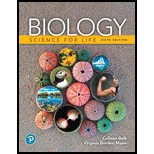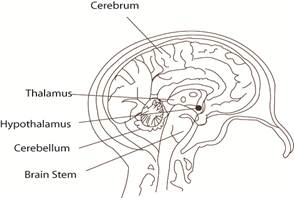
Concept explainers
To write:
To label: the different region of the human brain given in the figure.
Introduction:
The brain is an important part of the body where all the decisions about the body are processed, directed and coordinated.
Explanation of Solution
Structurally, the brain is sub-divided into many important anatomical regions, including the cerebrum, thalamus, cerebellum, hypothalamus, and brain stem.
The whole upper region of the skull is filled with Cerebrum. The cerebrum controls language, voluntary movement, sensation, memory, and decision making.
Thalamus relays information between the cerebrum and the spinal cord. The first part of the brain which receives message signaling such sensation as pain, pressure, and the temperature is thalamus.
The hypothalamus is the control center of sex drive, pleasure, pain, hunger, thrust, blood pressure, and body temperature. It also releases hormones including those regulating the production of egg cells and sperms as well as the menstruation cycle.
The cerebellum controls muscle movement, balance, and coordination. It looks like the smaller form of the cerebrum.
The brain stem consists of the pons, midbrain, and medulla oblongata. Midbrain is the uppermost area of the brain stem which adjusts the sensitivity of our eyes to light and ears to sound. Below the midbrain is the pons which functions as a bridge. The midbrain allows messages to travel from brain to the spinal cord. Medulla oblongata is the brain stem's lowest area. It helps to control the heart rate and conveys information between the spinal cord and other parts of the brain.
The figure shows the various region of the brain-

Fig:
Different part of the human brain
The given diagram shows the various region of the brain.
Want to see more full solutions like this?
Chapter 24 Solutions
EBK BIOLOGY:SCIENCE F/LIFE
- Noggin mutation: The mouse, one of the phenotypic consequences of Noggin mutationis mispatterning of the spinal cord, in the posterior region of the mouse embryo, suchthat in the hindlimb region the more ventral fates are lost, and the dorsal Pax3 domain isexpanded. (this experiment is not in the lectures).a. Hypothesis for why: What would be your hypothesis for why the ventral fatesare lost and dorsal fates expanded? Include in your answer the words notochord,BMP, SHH and either (or both of) surface ectoderm or lateral plate mesodermarrow_forwardNot part of a graded assignment, from a past midtermarrow_forwardNot part of a graded assignment, from a past midtermarrow_forward
- please helparrow_forwardWhat does the heavy dark line along collecting duct tell us about water reabsorption in this individual at this time? What does the heavy dark line along collecting duct tell us about ADH secretion in this individual at this time?arrow_forwardBiology grade 10 study guidearrow_forward
 Medical Terminology for Health Professions, Spira...Health & NutritionISBN:9781305634350Author:Ann Ehrlich, Carol L. Schroeder, Laura Ehrlich, Katrina A. SchroederPublisher:Cengage Learning
Medical Terminology for Health Professions, Spira...Health & NutritionISBN:9781305634350Author:Ann Ehrlich, Carol L. Schroeder, Laura Ehrlich, Katrina A. SchroederPublisher:Cengage Learning





